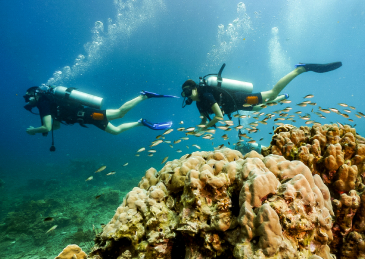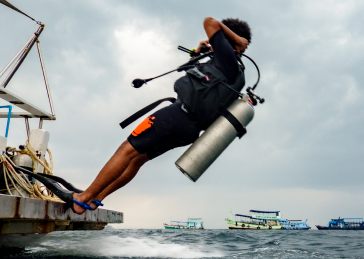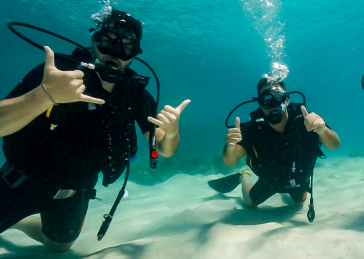20th May 2025
Exploring Koh Tao’s Underwater Wonders: A Marine Life Guide
Introduction
Koh Tao, Thailand’s renowned diving paradise, offers an extraordinary underwater world brimming with marine biodiversity. From powerful predators patrolling the blue to colorful reef dwellers, the island’s waters host a remarkable variety of sea life that captivates divers and snorkelers of all experience levels.
This comprehensive guide brings together our extensive coverage of Koh Tao’s most fascinating marine species. Whether you’re planning your first visit or looking to deepen your understanding of this tropical underwater ecosystem, these detailed species profiles will enhance your appreciation of what makes Koh Tao such a special destination.
Magnificent Predators of the Reef
Barracuda Species
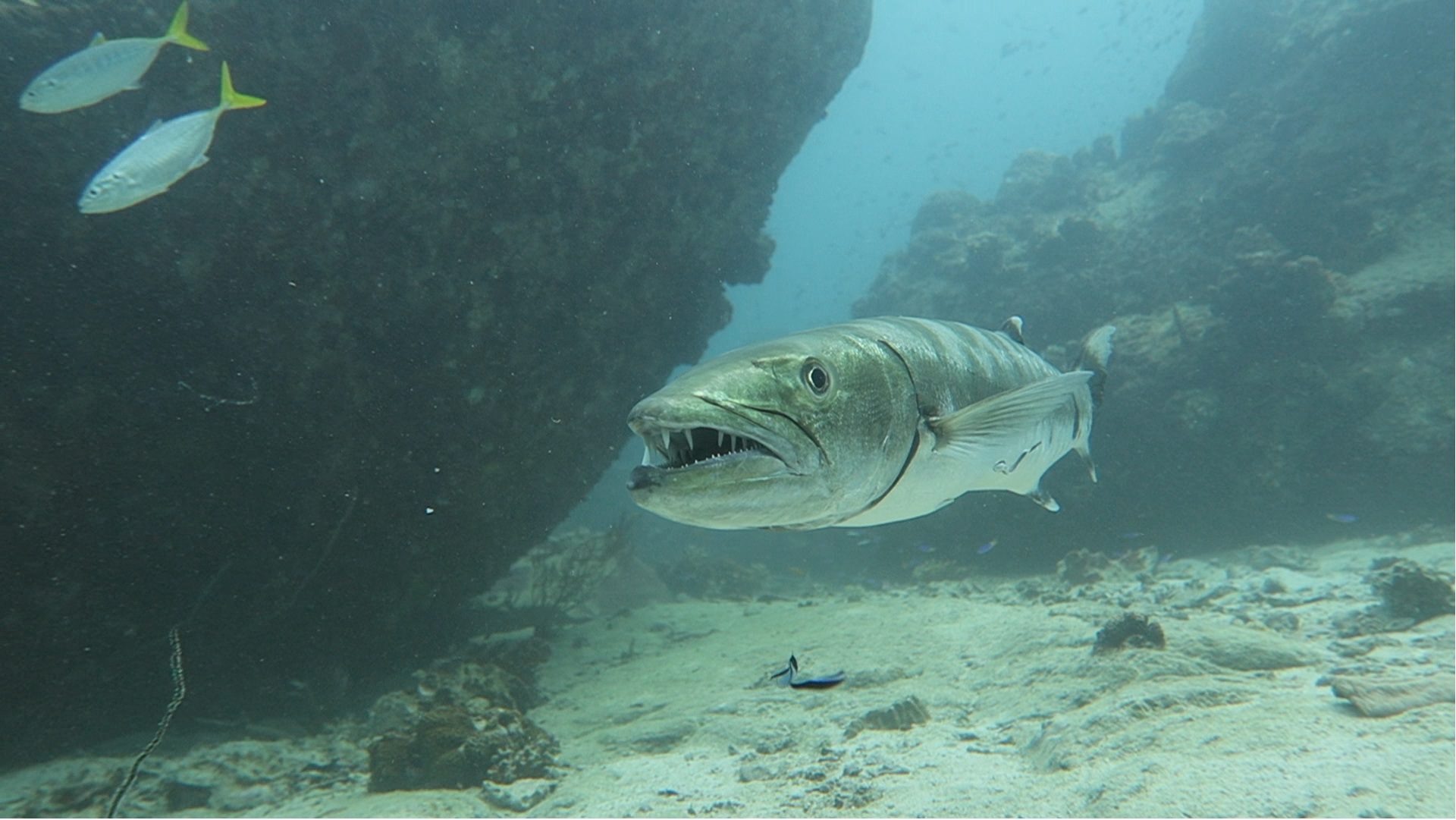
The waters surrounding Koh Tao are home to three distinctive barracuda species, each with unique characteristics and behaviors that make them fascinating to observe.
The impressive Great Barracuda (Sphyraena barracuda) can reach lengths of up to 1.8 meters and is typically solitary, while the Chevron Barracuda (Sphyraena putnamae) forms massive schools that create spectacular “tornado” formations. The smaller Pickhandle Barracuda (Sphyraena jello), recognized by its black-tipped fins and yellowish tail, frequents shallower waters accessible even to snorkelers.
These silver torpedoes represent some of the reef’s most efficient predators, with streamlined bodies and impressive hunting capabilities that have earned them both respect and admiration from divers.
For more information on Barracuda Koh Tao, click aquí.
Trevally Varieties
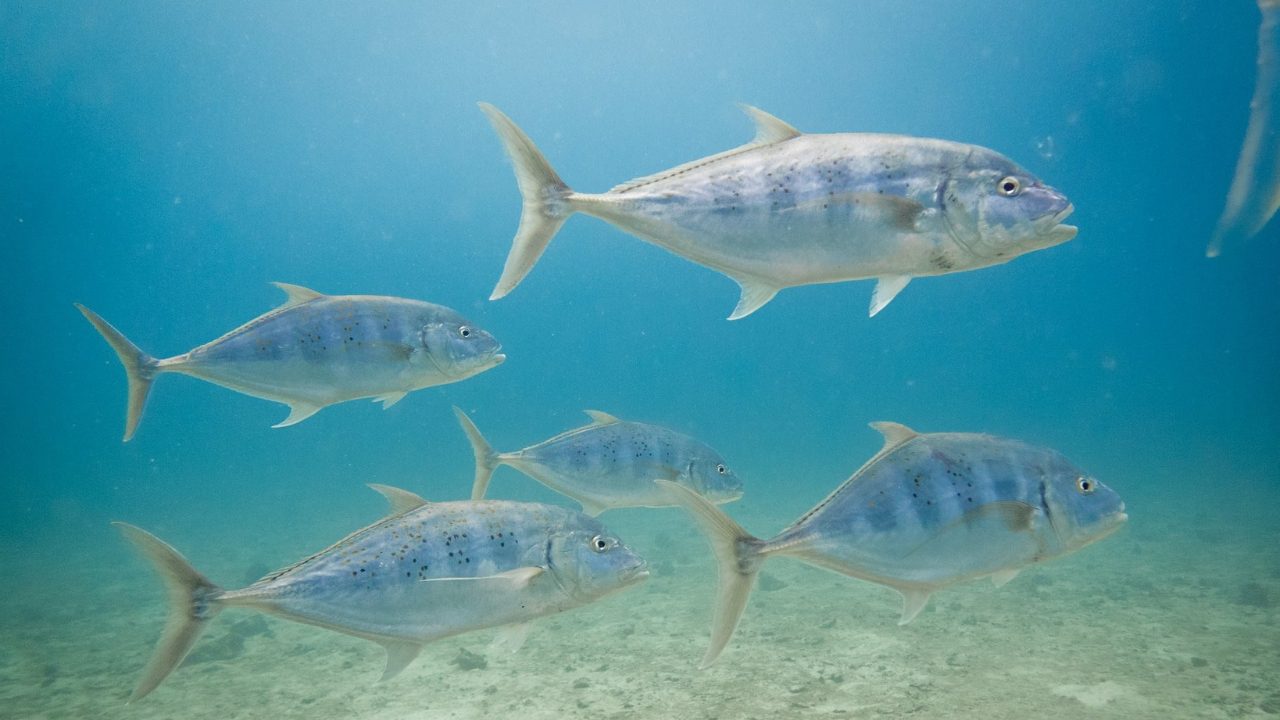
Koh Tao’s waters are patrolled by several impressive trevally species, powerful jacks that add excitement to many dive experiences around the island.
The formidable Bluefin Trevally (Caranx melampygus) rules as the undisputed apex predator among them, while the Bigeye Trevally (Caranx sexfasciatus) creates mesmerizing schooling formations that rank among the most spectacular underwater sights. Other notable trevally species include the Golden Trevally, recognizable by its brilliant yellow markings, and the Yellow-spotted Trevally with its distinctive golden speckles.
These powerful hunters demonstrate remarkable adaptability and intelligence, employing various strategies from solitary ambushes to coordinated group hunting techniques.
For more information on Trevally Koh Tao, click aquí.
Venomous Beauties
Lionfish
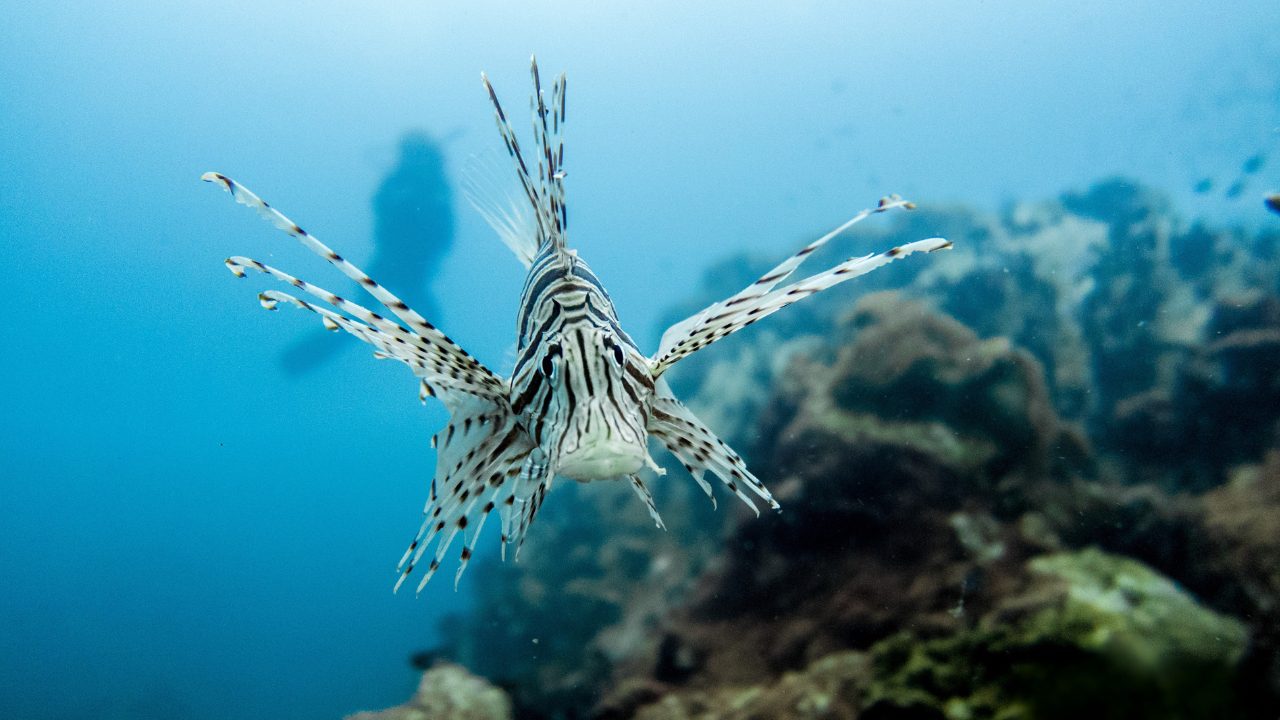
The elegant yet dangerous Lionfish (Pterois species) are among Koh Tao’s most visually striking inhabitants. With their distinctive fan-like pectoral fins adorned with dramatic red and white stripes and feathery appendages, they create an unmistakable silhouette against the reef backdrop.
Despite their exquisite beauty, these fish command respect due to their venomous spines that can deliver painful stings to unwary divers. Fortunately, their slow, hovering movement patterns make them easy to observe from a safe distance. Around Koh Tao, two species are commonly encountered: the Common Lionfish (Pterois volitans) and the Clearfin Lionfish (Pterois radiata), each with subtle variations in their magnificent appearance.
Their hunting strategy combines stealth, patience, and explosive speed, as they use their large pectoral fins to corner small prey fish before rapidly inhaling them in a single gulping motion that happens faster than the human eye can track.
For more information on Lionfish Koh Tao, click aquí.
Bearded Scorpionfish
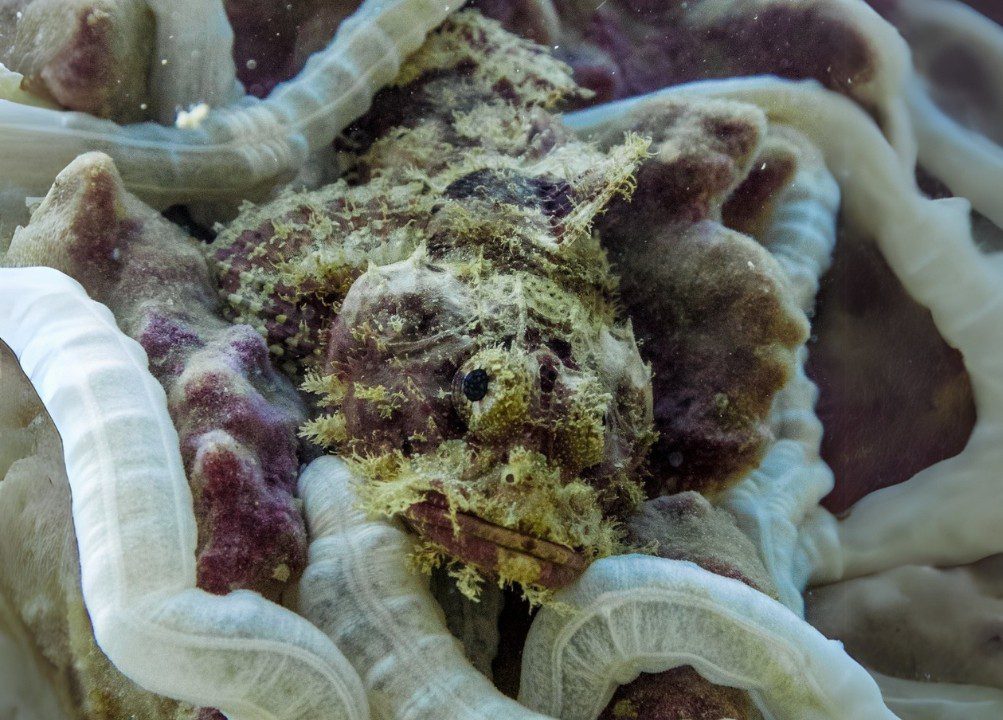
Masters of camouflage, the Bearded Scorpionfish (Scorpaenopsis barbata) represent some of the reef’s most accomplished ambush predators. These remarkable fish can be incredibly difficult to spot, as their mottled, textured bodies perfectly mimic the surrounding coral, rock, and algal surfaces where they patiently wait for prey.
The distinctive “beard” of fleshy tabs beneath their mouths adds to their extraordinary camouflage, breaking up their outline against complex reef backgrounds. Like their lionfish cousins, scorpionfish possess venomous spines requiring divers to maintain awareness and appropriate distance.
What makes bearded scorpionfish particularly fascinating is their incredible patience—they can remain motionless for hours, waiting for unsuspecting prey to venture within striking distance before exploding forward with surprising speed to engulf their meal in their cavernous mouths.
For more information on Bearded Scorpionfish Koh Tao, click aquí.
Masters of Disguise and Defense
Cuttlefish
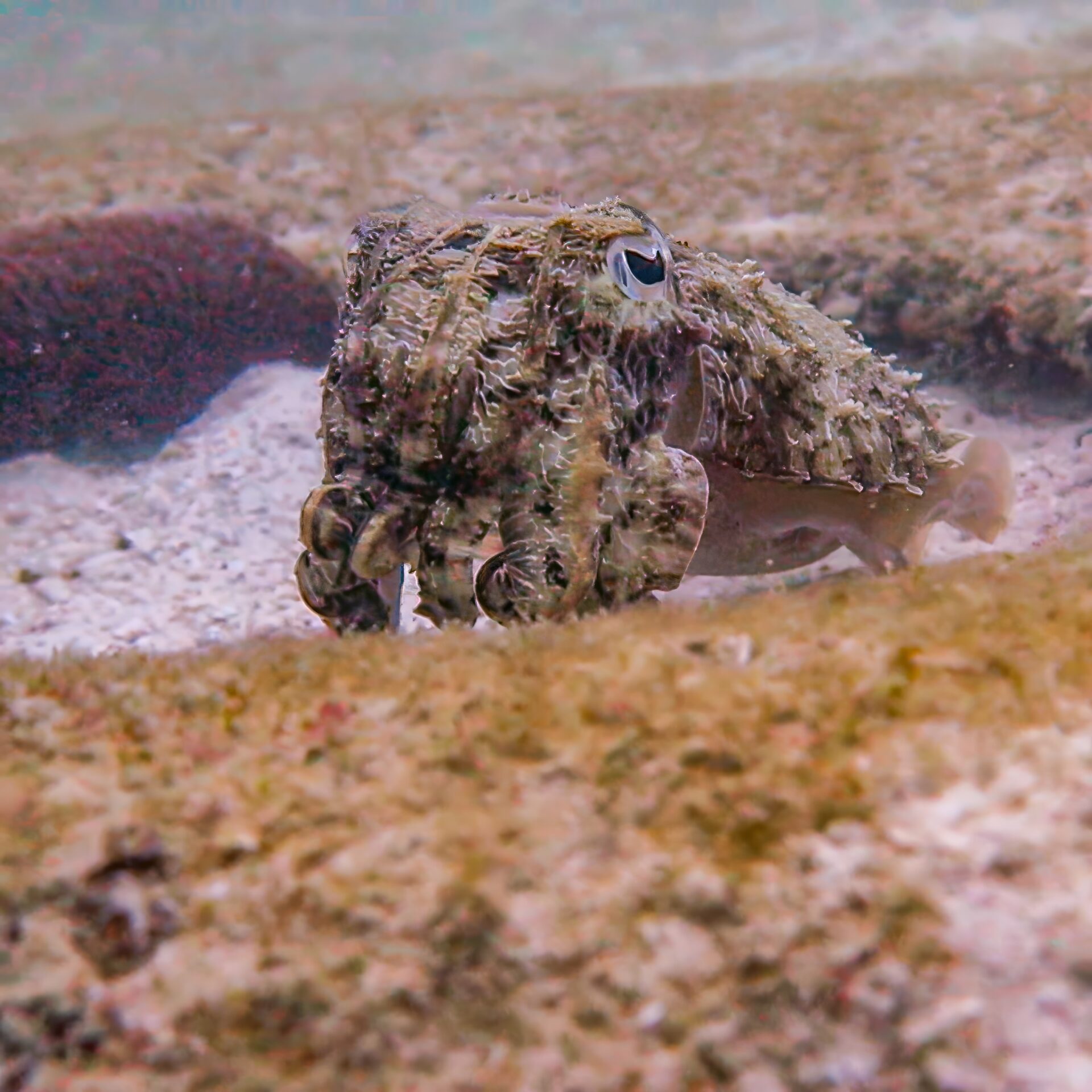
The waters around Koh Tao host the remarkable cuttlefish, masters of color-changing who captivate divers with their intelligence and dramatic displays. These sophisticated cephalopods possess an unmatched ability to transform their appearance instantaneously, using specialized cells called chromatophores to produce an astonishing array of colors and patterns.
Their complex behaviors, from elaborate mating rituals to sophisticated hunting techniques, offer some of the most intellectually stimulating wildlife encounters available to underwater observers around the island. With large, W-shaped pupils and expressive eyes, cuttlefish seem to observe divers with an awareness that feels almost alien yet strangely familiar.
Their hunting strategy employs both stealth and hypnosis—extending specialized tentacles with lightning speed while using rhythmic color changes to mesmerize prey before delivering a lethal bite with their powerful beaks.
For more information on Cuttlefish Koh Tao, click aquí.
Pufferfish Varieties
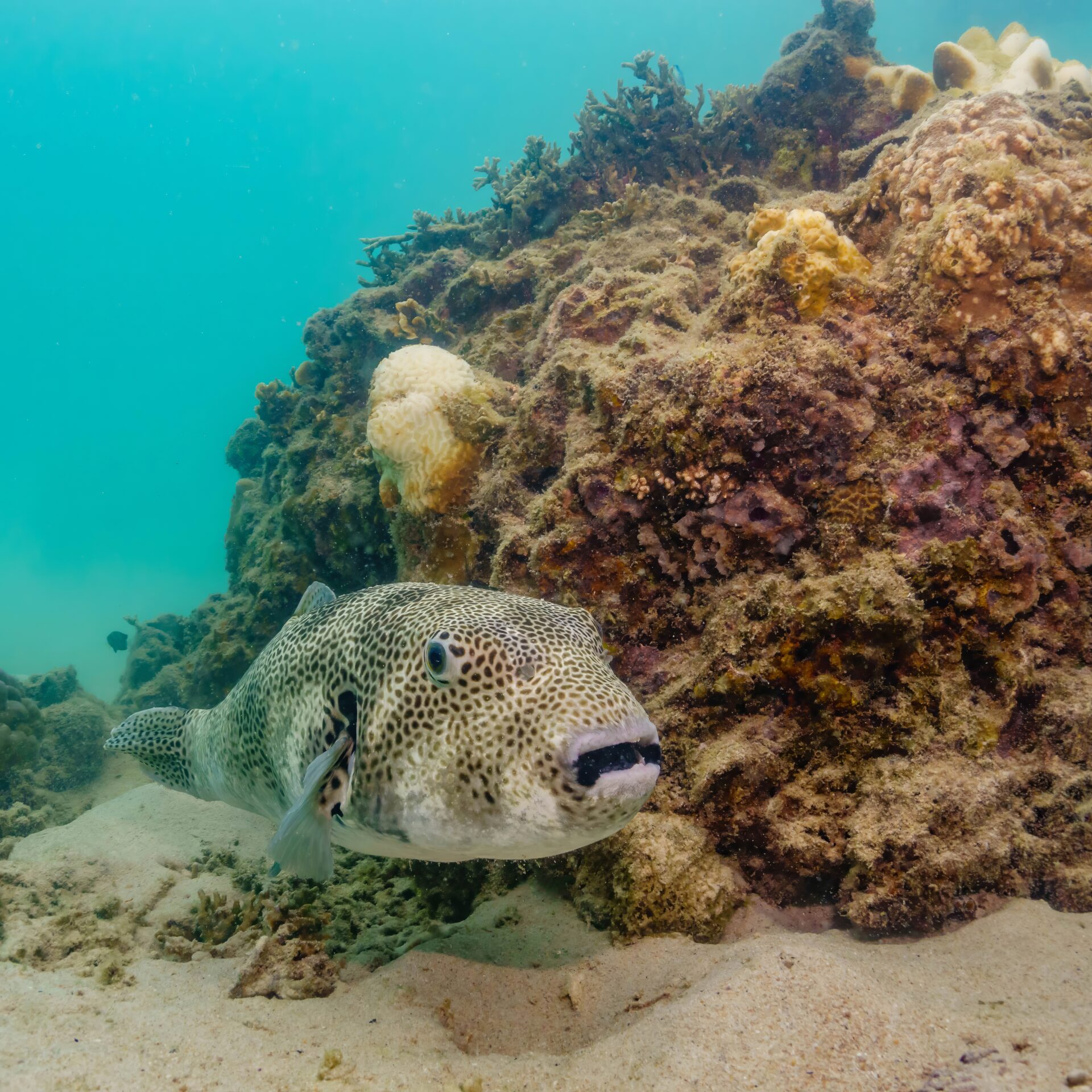
Koh Tao’s waters are home to several charismatic pufferfish species, including the impressive Giant Puffer, the spiky Porcupinefish, and the endearing Seal-faced Pufferfish. Each possesses unique defensive capabilities alongside distinctive appearances and behaviors that make them favorites among underwater photographers.
Local dive sites even feature individual celebrities like “Steve” the friendly porcupinefish at the Junkyard artificial reef, who has developed a remarkable comfort level with human visitors over years of respectful interactions.
Despite their formidable defense mechanism—the ability to rapidly inflate their bodies with water to transform into nearly spherical, spiny balls—these fish typically display curious and sometimes playful behavior when approached respectfully, creating some of the most memorable encounters for divers exploring Koh Tao’s reefs.
For more information on Pufferfish Koh Tao, click aquí.
Yellow Boxfish
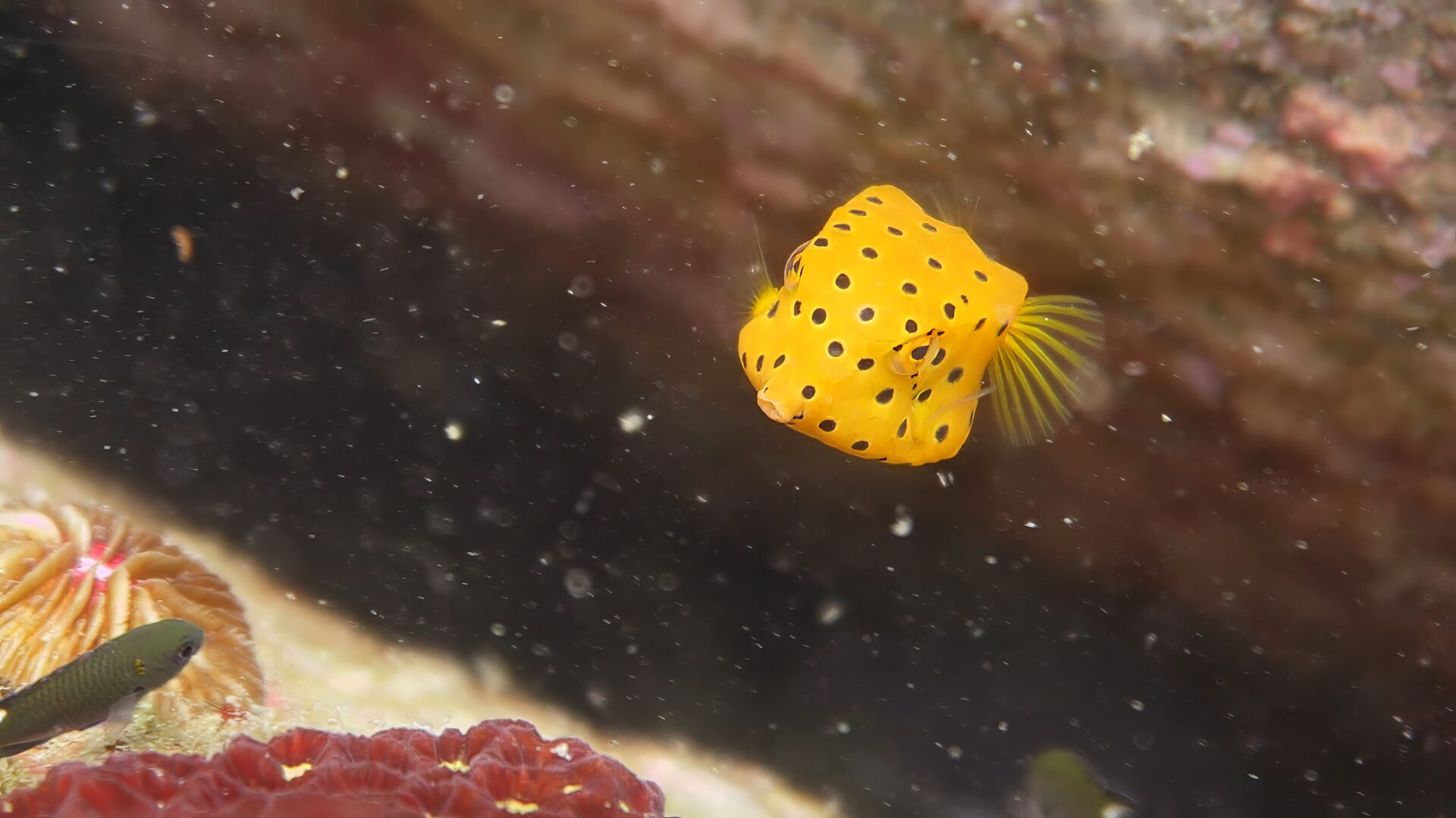
The charming Yellow Boxfish (Ostracion cubicus) brings a splash of vibrant color to Koh Tao’s underwater landscapes. These distinctive cubic-shaped fish appear almost cartoon-like as they navigate the reef with an endearing wobbling motion created by the synchronized waving of their transparent dorsal, anal, and caudal fins.
Juvenile Yellow Boxfish display a particularly vibrant lemon-yellow coloration with black polka dots, while adults develop a more complex pattern of blue markings over the yellow background. Despite their seemingly awkward shape, these fish are surprisingly agile and can maneuver effectively through complex reef structures.
Behind their charming appearance lies a sophisticated defense mechanism—when threatened, Yellow Boxfish can release ostracitoxin, a powerful neurotoxin that discourages potential predators. This chemical defense, combined with their rigid box-like structure, ensures they have few natural enemies on the reef.
For more information on Yellow Boxfish Koh Tao, click aquí.
Remarkable Reef Specialists
White-Eyed Moray Eels
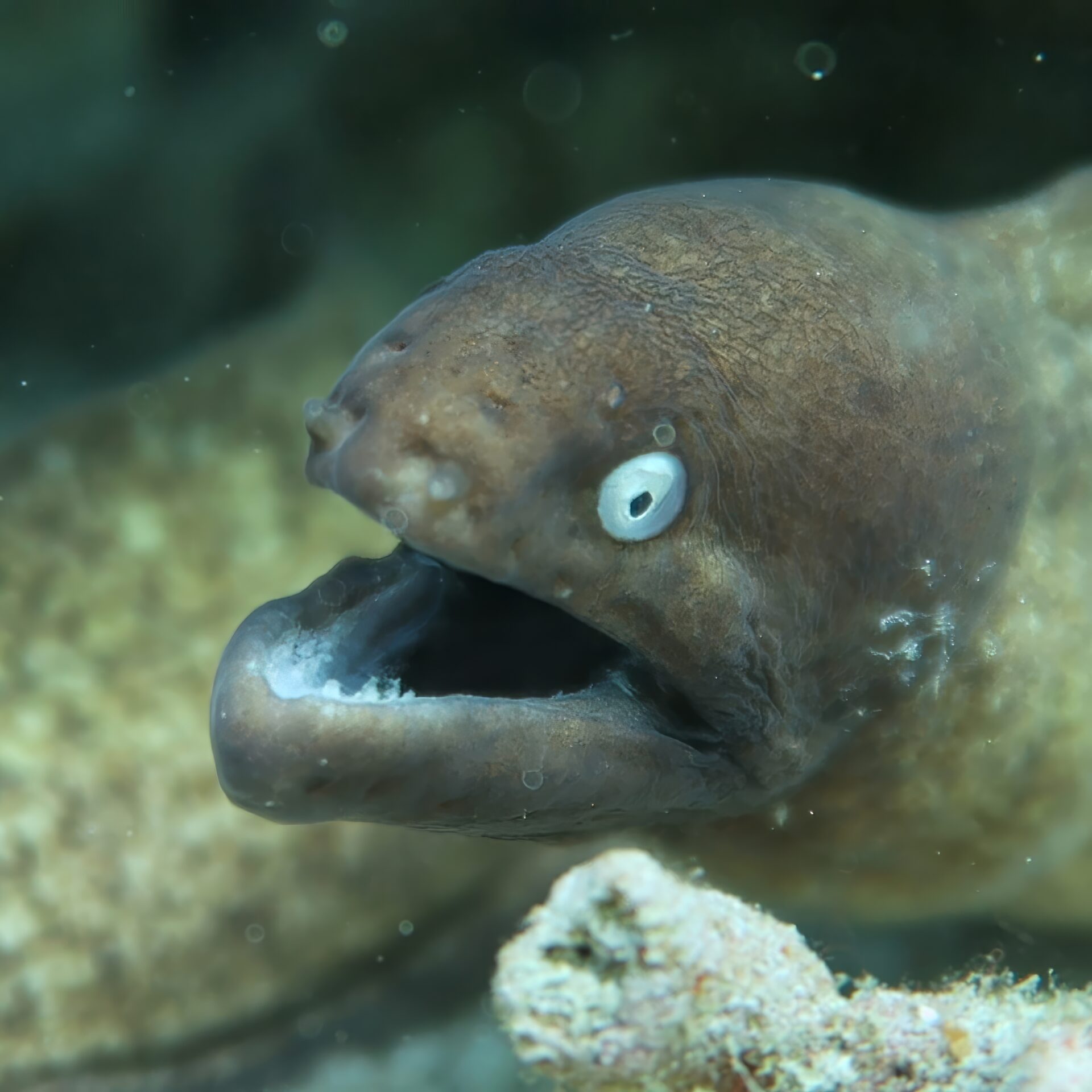
The distinctive White-Eyed Moray Eel (Gymnothorax thyrsoideus) adds character to Koh Tao’s reef crevices with its striking pale eyes contrasting against its mottled body. These fascinating predators play important ecological roles while challenging common misconceptions about eel behavior.
Despite their somewhat intimidating appearance with constantly open mouths showing sharp teeth, proper understanding reveals them to be naturally shy creatures that primarily use their open-mouthed appearance as a respiratory mechanism rather than an aggressive display.
For more information on Moray Eels Koh Tao, click aquí.
Batfish

The distinctive diamond-shaped Longfin Batfish (Platax teira) adds elegant character to Koh Tao’s underwater landscapes. These social creatures undergo dramatic transformations from juvenile to adult stages and often approach divers with apparent curiosity, creating memorable interactions.
Their ecological importance spans multiple habitat zones, as juveniles often shelter in shallow mangrove areas before moving to deeper reef systems as adults, creating connections between these different environments through their life cycles.
With their compressed, disc-like bodies and elongated dorsal and anal fins that extend far beyond the body’s outline, batfish create a striking silhouette against the blue water—particularly when observed in groups that sometimes number dozens of individuals at sites like Chumphon Pinnacle and White Rock.
For more information on Batfish Koh Tao, click aquí.
Elegant Reptiles
Banded Sea Krait
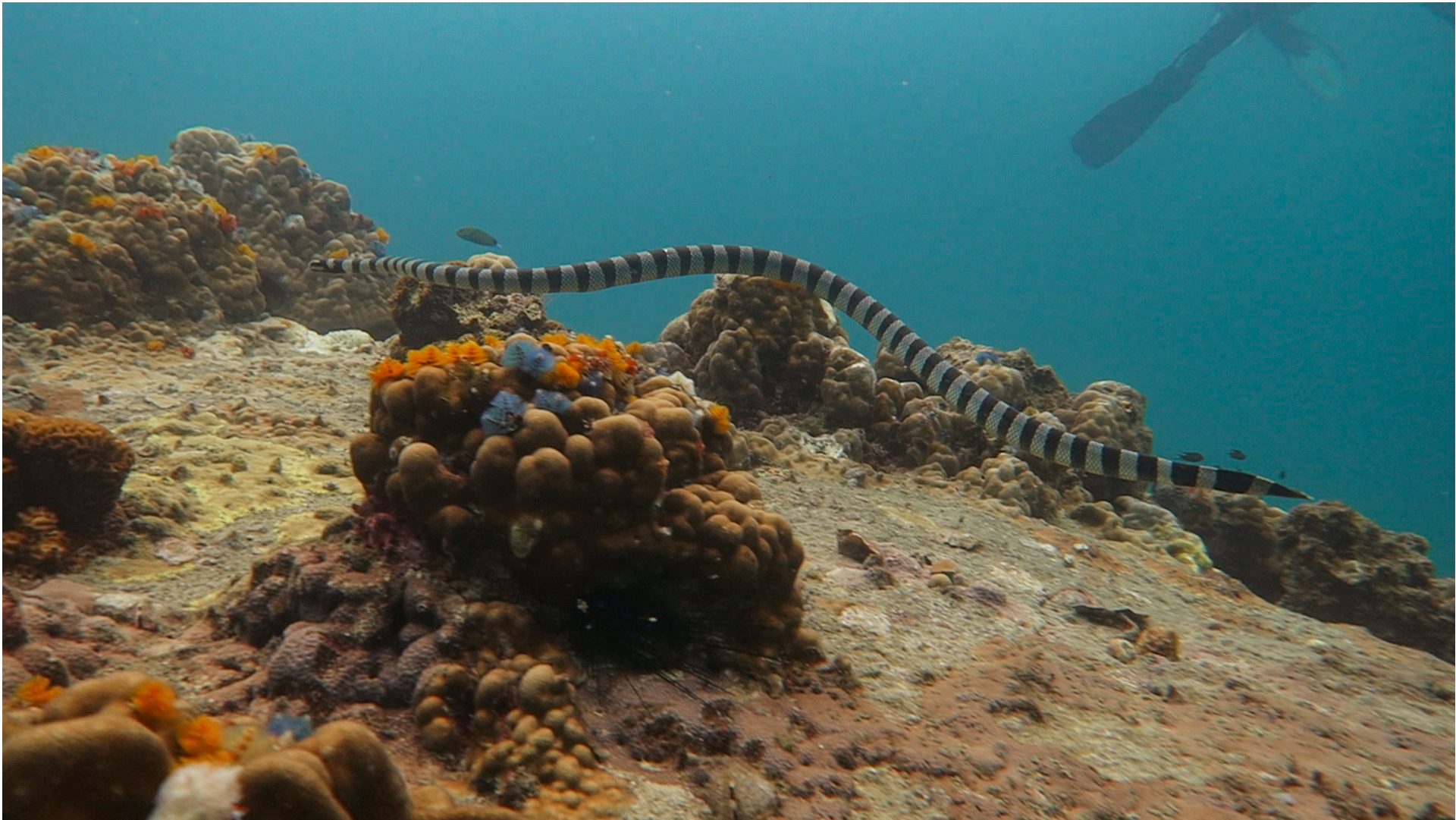
The beautiful yet potentially dangerous Banded Sea Krait (Laticauda colubrina) represents one of the few reptilian species regularly encountered in Koh Tao’s waters. These striking sea snakes are immediately recognizable by their distinctive pattern of alternating black and white (sometimes bluish-white) bands that encircle their bodies.
Despite possessing highly potent venom, Banded Sea Kraits are generally non-aggressive toward divers and focus primarily on hunting small eels and fish that they extract from crevices in the reef. Their unique evolutionary adaptation allows them to live a truly amphibious lifestyle—hunting underwater but returning to land to digest their prey, rest, and lay their eggs.
Around Koh Tao, these elegant reptiles are most commonly encountered at sites like Japanese Gardens, Twins, and Shark Island, where they can sometimes be observed swimming with purposeful movements between the surface and the reef or investigating holes and crevices in search of prey.
For more information on Banded Sea Krait Koh Tao, click aquí.
Conservation Awareness
The marine species highlighted throughout our blogs face various conservation challenges despite their protected status in Thai waters. Habitat degradation from climate impacts, coastal development pressures, and occasional fishing activities all create potential threats to these remarkable creatures.
By choosing responsible dive operators, practicing good buoyancy control, and supporting local conservation initiatives, visitors to Koh Tao can help ensure these magnificent marine species continue to thrive for future generations to enjoy.
For more information on Marine Conservation Koh Tao, click aquí.
Conclusión
Koh Tao’s underwater realm offers extraordinary biodiversity, from the massive schools of Bigeye Trevally to the solitary hunting prowess of the Great Barracuda, from the intelligence displayed by cuttlefish to the vibrant coloration of the Yellow Boxfish. Each species contributes to the complex ecological tapestry that makes this island’s marine environment so special.
Whether you’re an experienced diver or preparing for your first underwater adventure, understanding the remarkable adaptations, behaviors, and ecological roles of these species enhances appreciation for the underwater world and reinforces the importance of marine conservation efforts.
We hope these detailed species profiles inspire your underwater explorations around Koh Tao and contribute to a deeper connection with the magnificent marine life that calls these waters home.
For more information on other Koh Tao Marine Life, click aquí.
Preguntas frecuentes
1. What is the best time of year to see the most marine life diversity around Koh Tao?
March through September generally offers the optimal combination of conditions for marine life observation around Koh Tao. This period typically features calmer seas, better visibility (often exceeding 15-20 meters), and coincides with peak activity periods for many species including trevally schools, reef sharks, and various spawning behaviors. The reduced rainfall during these months minimizes runoff that can affect water clarity, especially at shallow coastal sites. While specific species can be observed year-round, the density and diversity of marine life encounters tend to be highest during these months. For visitors primarily interested in large pelagic species like Whale Sharks, February through May historically shows slightly higher sighting frequencies, though these magnificent visitors remain unpredictable in their appearances around the island.
2. Are any of Koh Tao’s marine species dangerous to divers or snorkelers?
The vast majority of marine species around Koh Tao pose no danger to responsible divers and snorkelers who practice appropriate underwater etiquette. Even species that might initially seem intimidating, such as barracudas, moray eels, and blacktip reef sharks, naturally avoid confrontation with humans. Some species do require specific awareness, including Lionfish and Scorpionfish with their venomous spines, Banded Sea Kraits with their potent venom (though they rarely bite humans), and certain pufferfish that are highly toxic if consumed. The primary rule for safe interaction is to maintain respectful distances and avoid touching or cornering any marine life. Following dive guide instructions, maintaining good buoyancy control, and respecting marine life’s personal space virtually eliminates any risk while maximizing enjoyable wildlife encounters.
3. How can I distinguish between similar-looking species underwater?
Distinguishing between similar species underwater becomes significantly easier by focusing on key identifying features rather than overall appearance. For trevally species, pay attention to specific markers: Bluefin Trevally have a steep forehead profile, Bigeye Trevally possess notably large eyes relative to head size with a small black spot on their gill cover, and Golden Trevally display yellow markings. For barracudas, observe the fin details: Great Barracudas have white-tipped fins, Pickhandle Barracudas show distinctive black fin tips and yellowish tails, while Chevron Barracudas feature prominent V-shaped markings along their sides. Local dive guides can help highlight these distinguishing characteristics during your initial encounters with these fascinating species.
4. Which marine species are most accessible for beginners or snorkelers around Koh Tao?
Many of Koh Tao’s marine species can be observed by beginners and even snorkelers at appropriate sites. The shallow reefs at Japanese Gardens, Aow Leuk, and Shark Bay provide excellent opportunities for snorkelers to encounter Yellow Boxfish, juvenile Batfish, and occasionally Pickhandle Barracuda schools. For newly certified divers, sites like Twins and White Rock offer reliable chances to observe many signature species including various moray eels, Lionfish, Scorpionfish, and sometimes cuttlefish, all at comfortable depths under 18 meters. Even some normally deep-water species occasionally venture into shallower areas—the famous Shark Bay allows snorkelers to observe Blacktip Reef Sharks in clear, shallow conditions during early morning hours. Beginners should consider scheduling a guided “marine life specialty” dive with local instructors who know exactly where and when to find specific creatures while ensuring appropriate safety standards.
5. What conservation initiatives are in place to protect Koh Tao’s marine species?
Several coordinated conservation initiatives work to protect Koh Tao’s marine biodiversity. At the national level, Thailand’s comprehensive fisheries regulations provide legal protections for many species, including a complete ban on shark fishing implemented in 2015. Locally, community-driven efforts include the designation of specific marine protected zones around the island where fishing activities are restricted or prohibited. Organizations like the New Heaven Reef Conservation Program conduct regular population monitoring using photo identification techniques, creating databases of individual animals that help track population trends and movement patterns. The dive industry has widely adopted responsible wildlife interaction guidelines that minimize tourism impacts while sharing the conservation message with thousands of visitors annually. Additionally, artificial reef projects strategically placed around the island help expand available habitat and create refuge areas, while regular beach and underwater cleanup initiatives reduce marine debris that can entangle or harm marine life.
Bucea con LBD: tu puerta a la exploración submarina
Whether you’re a curious beginner or a seasoned pro, our school is your portal to the wonders of scuba diving. Join us into the world beneath the waves.
¿LISTO PARA EMPEZAR?
Consulta nuestros cursos de buceo en Koh Tao
